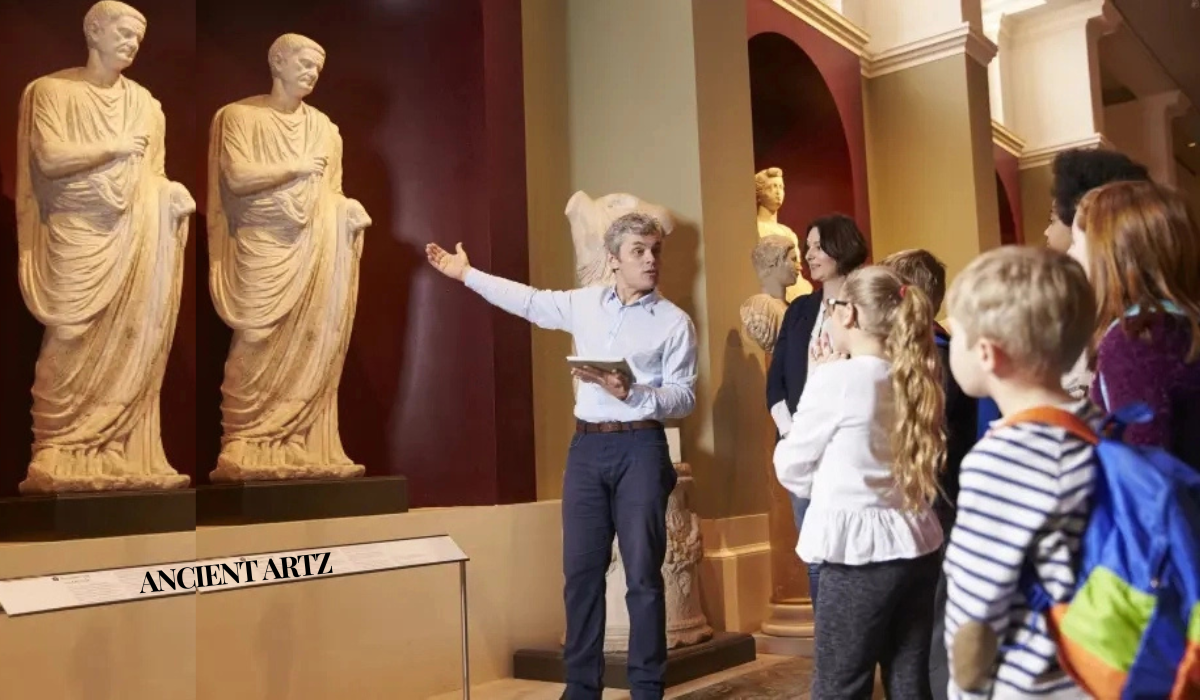Introduction
Ancient artz is more than just beautiful works crafted in stone, paint, or metal it’s a window into the past, revealing early civilisations’ lives, beliefs, and dreams. By studying ancient art, we gain insight into the creativity and resilience of human culture. It’s a testament to how humans have expressed their stories, emotions, and identities throughout history.
Ancient art continues to captivate our imaginations and shape our understanding of the past, from the awe-inspiring pyramids of Egypt to the intricate pottery of Greece. This article will take you on a fascinating journey through some of the world’s most compelling ancient artz. We will explore their cultural significance and how they influence our modern world.
Oldest Sculpture
The Venus of Willendorf is widely regarded as one of the oldest sculptures known to humanity. This limestone figurine, found in Austria, dates back approximately 25,000 BCE. Standing just over four inches tall, the Venus of Willendorf has captivated the imagination of historians and art enthusiasts alike.
This small sculpture represents a voluptuous female figure, thought to symbolize fertility and abundance. Its exaggerated features hint at its importance to the people who created it, possibly serving as a talisman or an object of worship. The Venus of Willendorf demonstrates how art can provide insight into cultural values and societal beliefs.
The discovery of this ancient sculpture highlights the universal human desire to create and express. Despite technological limitations, early humans found ways to craft extraordinary works of art that continue to inspire and intrigue us today.
Earliest Known Artwork
The earliest known artworks provide a fascinating glimpse into the creative beginnings of humankind.
- Cave Paintings – Cave paintings from Chauvet Cave in France, dated around 30,000 BCE, depict animals and abstract symbols. These ancient works suggest early humans’ artistic impulses and connection to nature.
- The Venus of Willendorf – This limestone figurine, found in Austria and dating back to 25,000 BCE, is one of the oldest known sculptures. Its exaggerated features may symbolize fertility and beauty, revealing the cultural values of early societies.
- Petroglyphs – Petroglyphs, or rock engravings, were created by chipping away at rock surfaces. Found worldwide, these ancient artworks provide insights into the beliefs and practices of early humans.
Modern Techniques in Art Conservation
Preserving ancient artworks is crucial for allowing future generations to appreciate and learn from these historical treasures. Modern techniques in art conservation play a vital role in maintaining the integrity and beauty of these pieces.
- Advanced Imaging – Conservators use non-invasive imaging technologies like infrared reflectography and X-ray fluorescence to analyze and document the condition of artworks without causing damage. These methods help uncover hidden details and inform restoration decisions.
- Digital Reconstruction – Digital technology allows conservators to recreate damaged or incomplete artworks, providing insights into their original appearance. This technique is beneficial for fragmented sculptures and murals.
- Environmental Controls – Museums and galleries implement strict environmental controls to protect ancient artworks from temperature, humidity, and light fluctuations. These measures prevent deterioration and prolong the lifespan of delicate materials like textiles and pigments.
The Influence of Religion on Ancient Artz
Religion has profoundly shaped ancient artworks, serving as both inspiration and purpose. Art was often used to convey spiritual beliefs and practices.
- Symbolism – Religious symbols and motifs were commonly used to depict deities, rituals, and spiritual concepts. For example, the lotus flower in Egyptian art symbolized rebirth and regeneration.
- Architecture – Temples, shrines, and altars were often intricately decorated with religious imagery. The Ziggurat of Ur in Mesopotamia and the Parthenon in Greece are iconic examples of architecture influenced by religious beliefs.
- Ritual Objects – Artifacts such as amulets, figurines, and offerings were created for religious ceremonies. These objects often held significant cultural and spiritual meaning.
Mayan Art
Mayan art is known for its complexity and sophistication, reflecting the advanced civilization of Mesoamerica.
- Murals – Mayan murals, created around 1000 BCE in Mexico and Guatemala, depicted gods, celestial events, and historical narratives. These vibrant paintings conveyed the importance of religion and cosmology in Mayan society.
- Sculpture – Mayan sculptures, often carved from stone or wood, portrayed deities, rulers, and mythological scenes. These works combined realism and symbolism, showcasing the skill and creativity of Mayan artisans.
- Ceramics – Mayan ceramics featured intricate designs, including geometric patterns and narrative scenes. These vessels served both practical and ceremonial purposes, highlighting the importance of art in daily life.
A Glimpse into African Art
African art provides a rich tapestry of cultural expression, reflecting the diverse societies and traditions across the continent.
- Rock Art – Ancient Saharan rock art, estimated to be around 8,000 years old, offers glimpses into early African civilisations’ daily lives and beliefs. These paintings and engravings often depicted animals, humans, and abstract symbols.
- Wooden Sculptures – African wooden sculptures flourished between 500 BCE and 1000 CE. These works varied from lifelike portraits to abstract representations, often serving religious or ceremonial purposes.
- Textiles and Pottery – African artisans excelled in textile weaving and pottery, creating functional and decorative items that remain influential in contemporary design.
The Art of Ancient China
Chinese art has a long and storied tradition characterized by intricate craftsmanship and profound symbolism.
- Terracotta Warriors – The discovery of approximately 8,000 life-sized warriors in Emperor Qin Shi Huang’s tomb is a testament to ancient China’s advanced sculptural techniques and the importance of the afterlife in Chinese culture.
- Silk Art – Silk painting and embroidery became popular art forms, showcasing the elegance and refinement of Chinese culture. These artworks often featured scenes from nature, mythology, and daily life.
- Calligraphy – Calligraphy was regarded as a high art form, emphasizing the beauty of written language. The fluid and expressive brushstrokes reflect the harmony between form and meaning.
Roman Art
Roman art is celebrated for its grandeur and realism, reflecting the power and sophistication of the Roman Empire.
- Mosaics – Intricate mosaics adorned homes and public spaces, depicting mythological scenes, daily life, and geometric patterns. These colourful artworks showcased the Roman mastery of technique and detail.
- Sculpture – Roman sculptures emphasized realism and individuality, capturing the likeness of emperors, gods, and ordinary citizens. These lifelike portraits were often used for political and commemorative purposes.
- Architecture – Monumental structures like the Colosseum and the Pantheon were adorned with elaborate sculptures and decorative elements, illustrating Roman society’s fusion of art and architecture.
Greek Art
Greek art is renowned for its emphasis on beauty, proportion, and harmony, laying the foundation for Western artistic traditions.
- Classical Sculptures – Emerging during the 5th century BCE, classical Greek sculptures focused on the ideal human form, capturing physical and emotional nuances. Renowned works like the Discobolus and the Venus de Milo exemplify this pursuit of perfection.
- Pottery – Greek pottery featured intricate designs and narratives, often depicting mythological stories and daily life. These vessels served both functional and decorative purposes.
- Temples – Greek temples, such as the Parthenon, were adorned with detailed sculptures and friezes, celebrating deities and historical events. These architectural marvels highlighted the Greeks’ commitment to balance and beauty.
Ancient Egyptian Art
Egyptian art is defined by its iconic visual style, characterized by symbolism and adherence to strict conventions.
- Hieroglyphics – Ancient Egyptian hieroglyphics, dating back to 3,200 BCE, contained over 700 symbols used for religious texts, inscriptions, and decorative purposes. These intricate scripts offer glimpses into ancient Egyptians’ beliefs and daily life.
- Sculpture and Painting – Egyptian art focused on depicting spiritual and political themes. Statues and reliefs of pharaohs, deities, and commoners followed established conventions to communicate their significance.
- Tombs and Temples – The grandeur of Egyptian tombs and temples, such as the pyramids and the Karnak Temple, demonstrated the importance of art in religious and funerary practices. These structures were adorned with detailed carvings and paintings, offering insights into the afterlife.
Mesopotamian Ziggurats
Mesopotamian ziggurats were monumental structures that served as both religious and administrative centres.
- Architectural Design – Ziggurats, such as the Ziggurat of Ur, built around 2100 BCE, were constructed with tiered platforms and staircases. These imposing structures symbolized the connection between the heavens and the earth.
- Religious Significance – Ziggurats were dedicated to specific deities and used for religious ceremonies. They played a crucial role in Mesopotamian cities’ spiritual and social life.
- Cultural Influence – The architectural style of ziggurats influenced subsequent cultures, including the Babylonians and Assyrians, who incorporated similar designs in their temples and palaces.
Indus Valley Civilization Art
The Indus Valley Civilization produced remarkable art and artefacts, reflecting its advanced urban culture.
- Pottery – Detailed pottery from the Indus Valley, active from 3300–1300 BCE, featured geometric patterns and motifs. These ceramics were used for storage, cooking, and religious rituals.
- Bronze Figurines – The Indus Valley is known for its exquisite bronze figurines, such as the famous “Dancing Girl.” These sculptures demonstrated the civilization’s mastery of metallurgy and artistic expression.
- Seals – Seals with intricate engravings were used for trade and administrative purposes. These artefacts provide insights into the Indus Valley Civilization’s writing system and social hierarchy.
Ancient Artz and Modern Society
Ancient artz continues to influence and inspire modern society in countless ways. These timeless masterpieces serve as a testament to the creativity and resilience of human culture, offering valuable insights into our shared history and identity.
Contemporary artists often draw inspiration from ancient artz, incorporating traditional techniques and motifs. This creative exchange fosters a deeper understanding of our cultural heritage and encourages new expressions of creativity and innovation.
The enduring appeal of ancient artz underscores the importance of preserving and celebrating our cultural heritage. By engaging with the art of the past, we gain a greater appreciation for the creativity and resilience that defines the human experience.
Conclusion
Ancient artz offers a captivating glimpse into the lives, beliefs, and dreams of those who came before us. From the awe-inspiring pyramids of Egypt to the intricate pottery of Greece, these timeless masterpieces continue to captivate our imagination and influence our world.
By exploring the rich history and diverse expressions of ancient artz, we gain a deeper understanding of our shared human experience. The enduring legacy of these works serves as a testament to the creativity and resilience that define our culture, offering timeless lessons about the power of art to connect and inspire.

